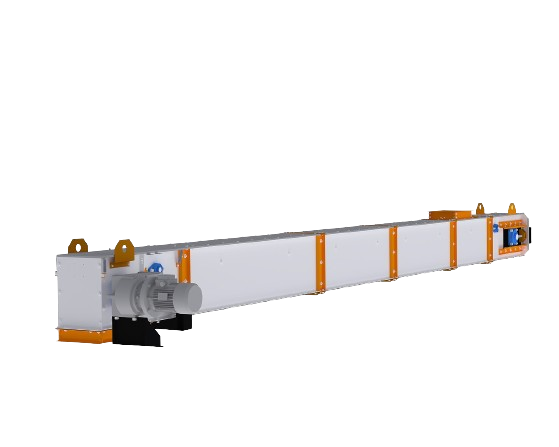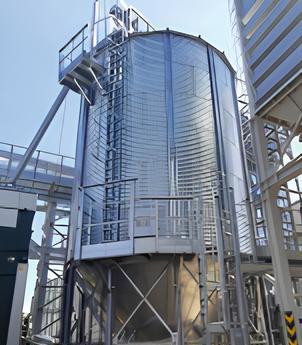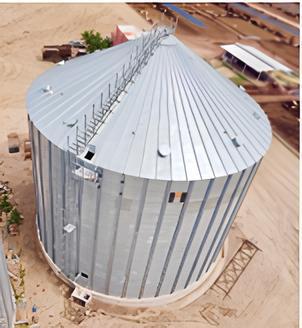GRAIN STORAGE METHODS
Grain can be stored in three ways:
- Loose storage on the floor
- Storage in concrete silos
- Storage in metal silos
These mentioned storage methods differ in their functions, with each storage method having its advantages and disadvantages.
The advantages of floor storage include continuous storage conditions, minimal mechanical damage to seeds, and the possibility of storing various batches of raw materials separately. The disadvantage of this storage method is the absence of mechanized cleaning because the raw materials are stored loosely, occupying large areas, and achieving adequate automation is challenging. Nevertheless, this method is suitable for long-term storage, especially for corn and oilseed crops.
Concrete silos are a reliable solution for both temporary and long-term grain storage. They have a high level of thermal insulation, so the quality of the stored material is not affected by weather conditions. On the other hand, the proportion of crushed particles of the stored material increases due to friction against the walls and bottom of the silo. The disadvantage of concrete silos also lies in their complicated maintenance.
Metal silos are the most modern storage capacities available in various types and sizes. Thanks to the storage of materials in metal silos, ventilation processes can be carried out, the quality of storage can be controlled, and the warehouse can be equipped with various mechanisms compatible with this type of storage equipment. The capacity options of metal silos are flexible, and it is possible to choose an appropriate silo size according to the quantity of stored material. Like the previous two storage methods, there are also certain disadvantages here. The primary disadvantage is the low level of thermal insulation of metal silos - for this reason, metal silos do not protect the stored material from low and high temperatures. As a result, condensation forms on the inner walls. Based on the above, metal silos are more suitable as accumulators or as temporary storage facilities.
Grain storage technologies depending on moisture content
For those engaged in pelletized compound feed production, determining the moisture content of raw materials is important. Based on the condition, raw materials can be divided into dry, moist, or raw. Depending on this, a specific grain storage technology is chosen. The moisture level in dry grain is below the standard for the crop. Dry mass can be stored in bulk, in a bunker, or preserved. To maintain its freshness, methods such as aeration, ventilation, sterilization, cooling, and treating are used. In such conditions, grains of any purpose – food, technical, seeds, or fodder grains for animal feed production – can be stored.
Moist grain is a mass with a moisture percentage exceeding the standard by 2-3%. It is loaded into silos or sealed, and cooling and preservation methods are applied. This method is suitable for storing crops of any purpose except seeds. Raw grain has moisture exceeding the normal level by more than 3%. Such raw materials are exclusively subjected to sealing – natural or chemical preservation. It is intended for direct feeding to livestock.
Grain loss during storage
Not only does the quality of grain change over time, but its weight and volume also change. This is due to moisture evaporation and seed respiration – air exchange that activates vital processes. Drying and processing can affect weight as well. The degree of grain loss during storage varies for different crops, with maize experiencing the highest weight loss – around 120 kg per ton over six months, while wheat loses about 70 kg per ton over the same period.
Methods to maintain quality
Let's consider methods by which natural processes within the grain mass can be controlled. The chosen method depends on its current condition and the final product's purpose.
Among the methods of maintaining quality are:
- Aeration
- Ventilation
- Cooling
-
Chemical disinfection
Aeration is used for floor storage. It involves passive ventilation of the grain storage or active direction of airflow. This is done to clean the air from gases and other decomposition products (CO , ethylene, water vapor) emitted by the mass. The procedure is particularly necessary if the storage facility is not equipped with a ventilation system.
Ventilation involves passing air currents through the grain mass to cool or dry it. Ventilation for drying is used only if the actual grain moisture exceeds the equilibrium moisture.
Cooling is active ventilation with dry cold air. The aim is to increase the biological resistance of the grain, extend its storage life, and eliminate pests and undesirable microorganisms. Cooling is performed by passing cooled air through the raw material or by running the raw material through the cooling shaft of a grain dryer.
Chemical disinfection is carried out using active chemicals that kill or suppress pest activity. This fairly radical method is used, in particular, for seed treatment before sowing.
In conclusion, it can be stated that grain can be stored in any state - from dried to raw. Preservation is carried out using both chemical and natural preservatives. Natural preservatives include substances formed in moist material during sealing - ethanol, carbon dioxide, acids, and essential oils. Chemical preservatives include mineral and organic acids, inert gases.
Taking into account the characteristics of the crop and the condition of the grains, as well as the use of suitable methods to increase the crop's resistance, high-quality raw materials can be preserved for several years.



